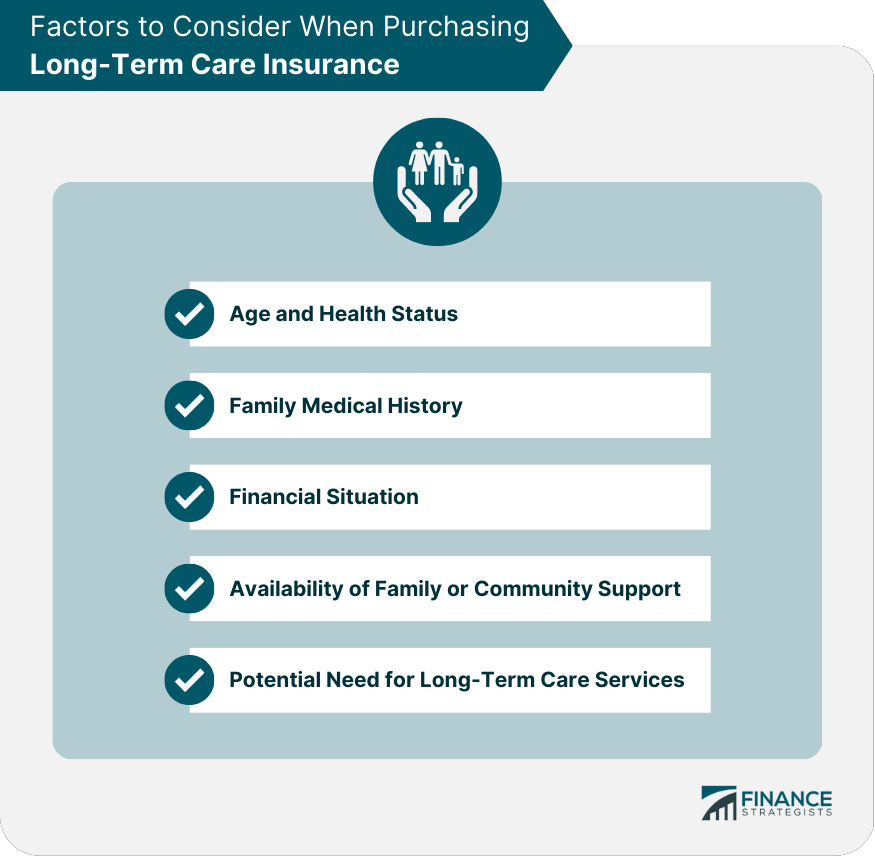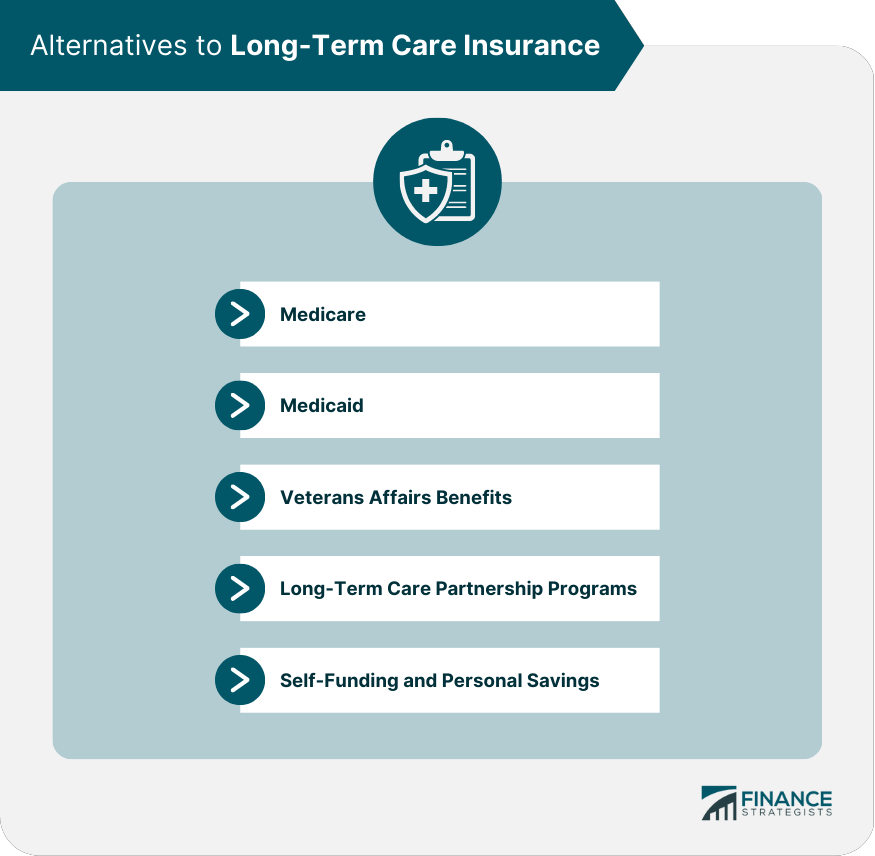Long-term care insurance is a specialized insurance product designed to help individuals cover the costs of long-term care services, such as nursing home care, assisted living, or in-home care. These services are typically not covered by standard health insurance or Medicare. This article will explore the importance of long-term care insurance, factors to consider when purchasing a policy, types of policies, key features, costs, and alternatives to long-term care insurance. The ideal time to purchase long-term care insurance is when you are relatively young and healthy, as premiums are lower and the likelihood of being denied coverage due to pre-existing conditions is reduced. Experts recommend considering long-term care insurance in your 50s or early 60s. If your family has a history of chronic illnesses or conditions requiring long-term care, such as Alzheimer's or Parkinson's disease, you may be at a higher risk of needing long-term care services. This should be a significant factor in your decision to purchase long-term care insurance. Long-term care insurance can be expensive, and it's essential to weigh the costs against your financial situation. It may not be the right choice if you have limited financial resources or if the premiums would be a significant burden on your budget. Consider whether you have family members or community resources who could provide care if needed. This support could lessen the need for a long-term care insurance policy. Evaluate your lifestyle and health habits to determine the likelihood of needing long-term care services. Factors such as obesity, smoking, and a sedentary lifestyle may increase the risk of requiring long-term care. This is the most common type of long-term care insurance, offering coverage for a variety of long-term care services. Policyholders pay regular premiums, and benefits are paid out if and when long-term care services are needed. These policies combine long-term care insurance with life insurance or annuity products. Policyholders can access long-term care benefits if needed, and if not used, the policy can provide a death benefit or an income stream. Some life insurance policies offer long-term care riders, which allow policyholders to access a portion of the death benefit for long-term care expenses. This option may be suitable for those who want both life insurance and long-term care coverage. Certain annuity products offer long-term care features, allowing policyholders to access a portion of the annuity value for long-term care expenses. This option can provide additional flexibility and may be appealing to those who want a guaranteed income stream and long-term care coverage. The benefit period refers to the length of time the policy will pay out benefits for long-term care services. Common options include two, three, five, or an unlimited number of years. The benefit amount is the daily or monthly maximum the policy will pay for long-term care services. This amount can vary depending on the policy and should be selected based on the potential cost of care in your area. The elimination period, sometimes called the waiting period, is the number of days you must pay for long-term care services out-of-pocket before the policy begins to pay benefits. Common elimination periods range from 30 to 90 days. Inflation protection helps ensure that your policy's benefits keep pace with the rising cost of long-term care services. This feature typically increases the benefit amount annually by a fixed percentage or based on the Consumer Price Index. Non-forfeiture benefits provide a limited amount of coverage if you decide to cancel your policy or stop paying premiums. This feature can offer some financial protection, ensuring you receive a portion of your paid premiums back in the form of benefits. The waiver of premium features allows policyholders to stop paying premiums while receiving long-term care benefits. This can help ease the financial burden during a time when policyholders are incurring significant care expenses. Premiums are the ongoing payments required to maintain coverage under a long-term care insurance policy. They can vary widely depending on factors such as age, health, policy features, and the insurance provider. Premiums are generally lower for younger individuals and may be higher for women, as they tend to live longer and are more likely to require long-term care services. Individuals with pre-existing conditions or poor health may face higher premiums or be denied coverage altogether. The benefit period, benefit amount, elimination period, inflation protection, and other features can significantly impact premium costs. Choosing a policy with more comprehensive coverage will generally result in higher premiums. Long-term care insurance premiums may be tax-deductible, depending on your age and whether the policy meets certain requirements. Additionally, benefits received from a qualified long-term care insurance policy are generally not considered taxable income. Choose a provider with a strong financial rating, as this indicates the company's ability to pay claims and maintain long-term stability. Select a provider known for excellent customer service and efficient claims processing to ensure a smooth experience when you need to access your benefits. Look for a provider that offers a range of policy options and customization, allowing you to tailor coverage to your specific needs. Research the provider's reputation and read reviews from current and former policyholders to gain insight into their experiences with the company. Medicare, the federal health insurance program for individuals aged 65 and older, offers limited coverage for long-term care services, primarily for short-term stays in skilled nursing facilities following a hospitalization. Medicaid, a state and federal program providing health coverage for low-income individuals, can cover long-term care services for eligible individuals. However, strict financial and eligibility requirements must be met to qualify for Medicaid-funded long-term care. The Department of Veterans Affairs (VA) offers long-term care benefits to eligible veterans and their spouses. Coverage and eligibility vary based on factors such as disability status, income, and available resources. These state-sponsored programs encourage individuals to purchase long-term care insurance by providing asset protection for Medicaid eligibility. Policyholders can retain a higher amount of assets when applying for Medicaid, depending on the benefits paid out by their long-term care insurance policy. Some individuals may opt to save and invest to cover future long-term care expenses instead of purchasing insurance. This approach requires careful planning and disciplined saving to ensure sufficient funds are available if long-term care services are needed. In conclusion, long-term care insurance is an essential consideration for individuals who want to protect their financial future in the event of needing long-term care services. Age, health status, family medical history, financial situation, and potential need for long-term care are critical factors to consider when choosing a policy. There are different types of policies available, such as traditional, hybrid, life insurance with long-term care riders, and annuities with long-term care features, each with unique features and costs. Key features of long-term care insurance policies, such as the benefit period, benefit amount, elimination period, inflation protection, nonforfeiture benefits, and waiver of premium, should also be considered when evaluating different policies. Ultimately, choosing a reputable provider with strong financial stability, excellent customer service and claims processing, and policy options and flexibility is crucial for ensuring that you are adequately protected when you need long-term care services.What Is Long-Term Care Insurance?
Factors to Consider When Purchasing Long-Term Care Insurance
Age and Health Status
Family Medical History
Financial Situation
Availability of Family or Community Support
Potential Need for Long-Term Care Services

Types of Long-Term Care Insurance Policies
Traditional Long-Term Care Insurance
Hybrid or Combination Policies
Life Insurance With Long-Term Care Riders
Annuities With Long-Term Care Features
Key Features of Long-Term Care Insurance Policies
Benefit Period
Benefit Amount
Elimination Period
Inflation Protection
Nonforfeiture Benefits
Waiver of Premium
Long-Term Care Insurance Policy Costs
Premiums
Factors Affecting Premium Costs
Age and Gender
Health Status
Policy Features
Tax Implications and Deductions
Evaluating Long-Term Care Insurance Providers
Financial Strength and Stability
Customer Service and Claims Processing
Policy Options and Flexibility
Reputation and Reviews
Government Programs and Alternatives to Long-Term Care Insurance
Medicare
Medicaid
Veterans Affairs Benefits
Long-Term Care Partnership Programs
Self-Funding and Personal Savings

Conclusion
Long-Term Care Insurance FAQs
Long-term care insurance is a type of insurance that covers the costs of care in case of an illness, injury, or disability that requires long-term assistance with daily activities.
Long-term care insurance is recommended for individuals who want to ensure that they have the resources to cover the costs of long-term care, which can be quite expensive, and don't want to rely solely on their savings.
The cost of long-term care insurance varies depending on factors such as age, health, and coverage amount. Premiums typically increase with age and are lower for individuals who purchase the insurance at a younger age.
Long-term care insurance covers the costs associated with long-term care, including nursing home care, assisted living facilities, and in-home care. Coverage may also include hospice care, adult daycare, and respite care.
Long-term care insurance premiums may be tax-deductible if the policy meets certain criteria established by the IRS. Additionally, benefits received from a long-term care insurance policy are generally tax-free. It is advisable to consult a tax professional for guidance on specific tax matters related to long-term care insurance.
True Tamplin is a published author, public speaker, CEO of UpDigital, and founder of Finance Strategists.
True is a Certified Educator in Personal Finance (CEPF®), author of The Handy Financial Ratios Guide, a member of the Society for Advancing Business Editing and Writing, contributes to his financial education site, Finance Strategists, and has spoken to various financial communities such as the CFA Institute, as well as university students like his Alma mater, Biola University, where he received a bachelor of science in business and data analytics.
To learn more about True, visit his personal website or view his author profiles on Amazon, Nasdaq and Forbes.











